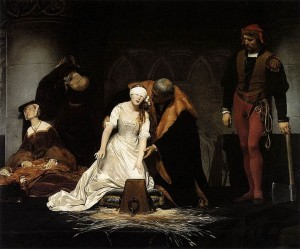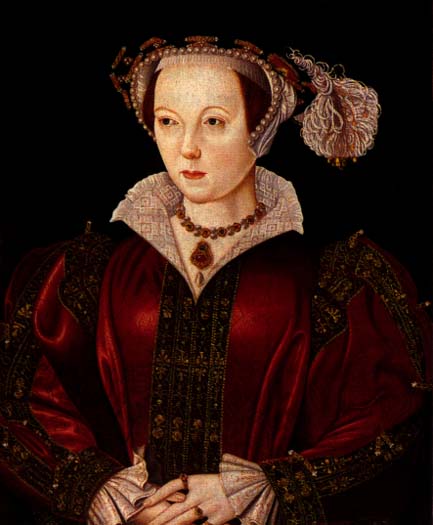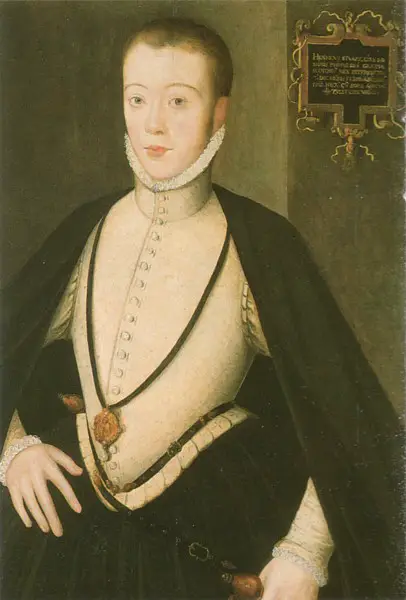
The Execution of Lady Jane Grey by Paul Delaroche (1833)
The monday, being the xijth of Februarie, about ten of the clocke, ther went out of the Tower to the scaffolde on Tower hill, the lorde Guilforde Dudley, sone to the late duke of Northumberland, husbande to the lady Jane Grey, daughter to the duke of Suffolke, who at his going out tooke by the hande sir Anthony Browne, maister John Throgmorton, and many other gentyllmen, praying them to praie for him; and without the bullwarke Offeley the sheryve receyved him and brought him to the scaffolde, where, after a small declaration, having no gostlye father with him, he kneeled downe and said his praiers; then holding upp his eyes and handes to God many tymes; and at last, after he had desyred the people to pray for him, he laide himselfe along, and his hedd upon the block, which was at one stroke of the axe taken from him.
Note, the lorde marques stode upon the Devyl's towre, and sawe the executyon. His carcase thrown into a carre, and his hed in a cloth, he was brought to the chapell within the Tower, where the ladye Jane, whose lodging was in Partrige's house, dyd see his ded carcase taken out of the cart, aswell as she dyd see him before on lyve going to his deathe, a sight to hir no lesse than death.
By this tyme was ther a scaffolde made upon the grene over agaynst the White tower, for the saide lady Jane to die apon. Who with hir husband was appoynted to have ben put to deathe the fryday before, but was staied tyll then, for what cause is not knowen, unlesse yt were because hir father was not then come into the Tower. The saide lady, being nothing at all abashed, neither with feare of her owne deathe, which then approached, neither with the sight of the ded carcase of hir husbande, when he was brought in to the chappell, came fourthe, the levetenaunt leding hir, in the same gown wherin she was arrayned, hir countenance nothing abashed, neither her eyes enything moysted with teares, although her ij. gentylwomen, mistress Elizabeth Tylney and mistress Eleyn, wonderfully wept, with a boke in hir hande, whereon she praied all the way till she cam to the saide scaffolde, wheron when she was mounted, &c.
The Ende of the lady Jane Dudley, daughter of the duke of Suffolk, upon the scaffolde, at the houre of her death.
First, when she mounted upon the scaffolde, she sayd to the people standing thereabout: "Good people, I am come hether to die, and by a lawe I am condemned to the same. The facte, in dede, against the quene's highnesse was unlawfull, and the consenting thereunto by me: but touching the procurement and desyre therof by me or on my halfe, I doo wash my handes thereof in innocencie, before God, and the face of you, good Christian people, this day," and therewith she wrong her handes, in which she had hir booke. Then she sayd, "I pray you all, good Christian people, to beare me witnesse that I dye a true Christian woman, and that I looke to be saved by none other meane, but only by the mercy of God in the merites of the blood of his only sonne Jesus Christ: and I confesse, when I dyd know the word of God I neglected the same, loved my selfe and the world, and therefore this plague or punyshment is happely and worthely happened unto me for my sins; and yet I thank God of his goodnesse that he hath thus geven me a tyme and respet to repent. And now, good people, while I am alyve, I pray you to assyst me with your prayers." And then, knelyng downe, she turned to Fecknam [the new dean of St Paul's], saying, "Shall I say this psalme?" And he said, "Yea." Then she said the psalme of Miserere mei Deus, in English, in most devout maner, to the end. Then she stode up, and gave her maiden mistris Tilney her gloves and handkercher, and her book to maister Bruges, the lyvetenantes brother; forthwith she untyed her gown. The hangman went to her to help her of therewith; then she desyred him to let her alone, turning towardes her two gentlewomen, who helped her off therwith, and also with her frose paast [either Fronts-piece or frow's paste (or matronly head-dress)] and neckercher, geving to her a fayre handkercher to knytte about her eyes.
Then the hangman kneeled downe, and asked her forgevenesse, whome she forgave most willingly. Then he willed her to stand upon the strawe: which doing, she sawe the block. Then she sayd, "I pray you dispatch me quickly." Then she kneeled down, saying, "Will you take it of before I lay me downe?" and the hangman answered her, "No, madame." She tyed the kercher about her eys; then feeling for the blocke, saide, "What shall I do? Where is it?" One of the standers-by guyding her thereunto, she layde her heade down upon the block, and stretched forth her body and said: "Lorde, into thy hands I commende my spirite!" And so she ended.
You can read The chronicle of Queen Jane, and of two years of Queen Mary at https://openlibrary.org/books/OL7144229M/The_chronicle_of_Queen_Jane_and_of_two_years_of_Queen_Mary_and_especially_of_the_rebellion_of_Sir_Th
You can find links to other primary sources on Lady Jane Grey on our Lady Jane Grey Primary Sources page.



I enjoy the post on royalty. Hope you continue.
I love these informative posts on historical events. Absolutely fascinating!! Thank you xx
I am currently reading Alison Weir’s Innocent Traitor, & have become a big fan of Lady Jane!
Have you read Leanda de Lisle’s “The Sisters Who Would be Queen” about the Grey sisters? I love that one.